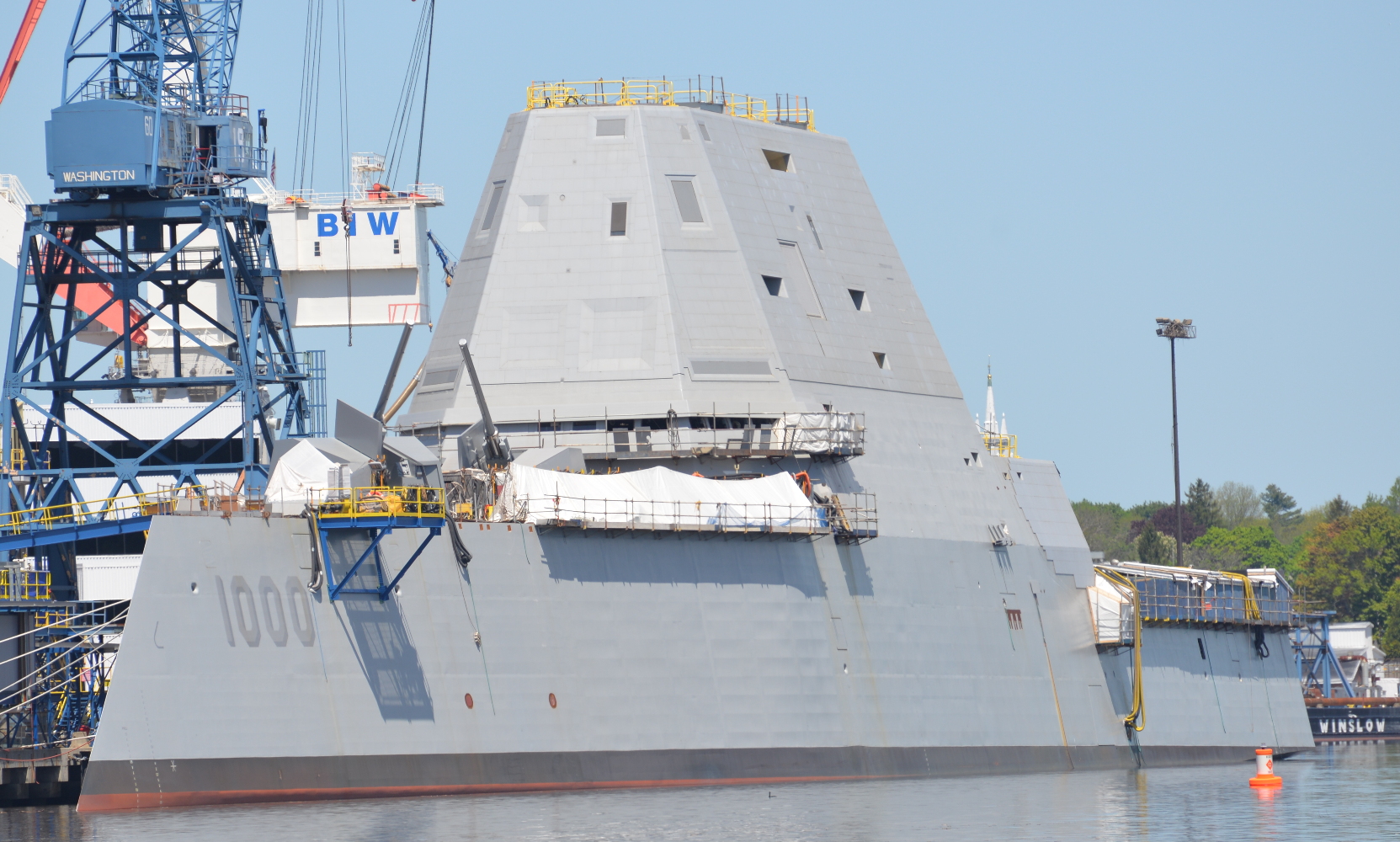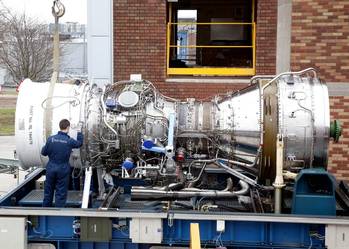 |
| ZUMWALT (DDG 1000): The Future Is Getting Closer |
 |
| Successful MTG Light Off for USS Zumwalt |
Rolls-Royce Selected to Power New Navy Destroyer
Rolls-Royce will supply the U.S. Navy’s surface combatant ship with the world’s most powerful marine gas turbine. Four MT30 gas turbine generator sets will be supplied for two DDG-1000 Zumwalt Class destroyers, with deliveries of the 36MW MT30 sets to begin in 2009. An MT30 generator set currently provides power to the U.S. Navy’s DDG-1000 Land Based Test Site in Philadelphia and the MT30 has also been selected to power the first two Lockheed Martin Littoral Combat Ships.apparently they beat GE - Military | Marine Propulsion | Engines | GE Aviation
DDG 1000: Milestone at U.S. Navy Test Site
Converteam in partnership with the U.S. Navy have successfully tested the DDG 1000’s high voltage Integrated Power System (IPS)(1) to full power at the Land Based Test Site located in Philadelphia, Pennsylvania. DDG 1000 is the first U.S. Navy surface combatant to leverage this technology—an all-electric architecture providing electric power for both propulsion and ship services.G.E. to Buy Converteam for $3.2 Billion - NYTimes.com
Converteam now part of GE.
USS ZUMWALT Plugged In
PHILADELPHIA - The pre-commissioning crew of future USS Zumwalt (DDG 1000) completed training March 14 at Naval Surface Warfare Center Carderock Division – Ship Systems Engineering Station (NSWCCD-SSES) where they learned to operate the unique systems of the U.S. Navy’s first all-electric ship. This was the first opportunity for the crew to get hands-on experience operating and maintaining the Integrated Power System (IPS).
Future USS Zumwalt (DDG 1000) achieves successful light-off of first main turbine generator set
Onboard the Zumwalt are two Rolls-Royce MT30 Main Turbine Generator Sets (MTGs) and two RR4500 Auxiliary Turbine Generator Sets (ATGs) that will provide a total of 78 MW for total ship power - the MTGs provide 35.4 MW each and the ATGs 3.8 MW each.
The MT30 is the most power dense marine gas turbine in the world, selected to power the most modern and advanced vessels in the US Navy, including the Freedom Class Littoral Combat Ship, as well as with the Royal Navy’s Queen Elizabeth Class aircraft carriers, the innovative Type 26 Global Combat Ship, and the Republic of Korea Navy’s FFX Batch II frigate.
Turboelectric Drive in American Capital Ships
Electrical propulsion was tried before, but advanced electric propulsion technology makes it now economical and feasible.Turboelectric drive offers several advantages:
- There is no mechanical connection between the turbogenerator shaft and the propeller shaft, allowing both to turn at their disparate efficient speeds. This reduces propeller rotation speeds and increases fuel efficiency.
- The motor rooms can be placed nearer the stern than can reduction-geared turbines, eliminating the need to lead the propeller shafts farther forward in the ship.
- The machinery components are more easily segregated into multiple compartments, and require fewer steam line penetrations of watertight bulkheads.
- The turbo-electric drive consumes less beam, allowing more hull breadth to be devoted to the torpedo defense system.
- The propeller shafts can be immediately reversed by simply switching the direction of the electric motors without the need to reroute steam to a separate reversing turbine.
- Equal power (but not speed) is available for ahead or astern steaming. Astern steaming can also be maintained indefinitely.
- The machinery is more easily cross-connected in the event of battle damage through the switching of electrical loads between different turbogenerators and motors, and the elimination of propulsive steam lines.
- More steam is available at all power levels for the ship's service turbogenerators (SSTGs), making more power available for ancillary systems (including main battery elevation and training) and electronics.
- Most major electrical components are reparable by the ship's company at sea.
- It is heavier and more expensive than a direct drive or reduction geared turbine installation.
- It is susceptible to turbogenerator room damage.
- It is susceptible to damage to the main control compartment containing the bus bar system.
- It is susceptible to shorting out from shock damage to the bus bar system.
Electrical Propulsion Tougher to knock out than you might think:
Eight US Navy capital ships with turboelectric propulsion; Damage
suffered:
- BB-40 New Mexico- 06 Jan 45 Kamikaze ; 12 May 45, Kamikaze - Plant replaced by geared turbines during reconstruction.
- BB-43 Tennessee - First installation with refined subdivision. - 07 Dec 41 2 bombs; 14 Jun 44 3 coastal artillery shells; 12 Apr 45 Kamikaze
- BB-44 California - 07 Dec 41 2 torpedoes; 2 bombs [Sunk, Salvaged] ; 14 Jun 44 1 coastal artillery shell ; 06 Jan 45 Kamikaze
- BB-45 Colorado - 24 Jul 44 22 coastal artillery shells ; 27 Nov 44 2 Kamikazes ; 09 Jan 45 Multiple friendly AA shells
- BB-46 Maryland - 07 Dec 41 2 bombs ; 14 Jun 44 1 torpedo ; 29 Nov 44 Kamikaze ; 07 April 45 Kamikaze
- BB-48 West Virginia - Completed under Treaty in exchange for Mutsu. - 07 Dec 41 9 torpedoes; 2 bombs [Sunk, Salvaged] ; 01 Apr 45 Kamikaze
- CC-1 Lexington - Completed as carrier (CV-2 Lexington) under Treaty.- 08 May 42 2 torpedoes; 2 bombs [Scuttled, Sunk]
- CC-3 - Saratoga - Completed as carrier (CV-3 Saratoga) under Treaty. -11 Jan 42 1 torpedo 31 Aug 42 1 torpedo ; 21 Feb 45 3 bombs; 4 Kamikazes
BB40 USS New Mexico |
first electric propelled battleship
commissioned on 20 May 1918
BB40, USS New Mexico had turbo-electric transmission, in which the high-speed steam turbine drove a set of generators providing electricity to electric motors turning the propeller shafts. General Electric ran an advertisement titled "The "Constitution" of To-day — Electronically Propelled" with a drawing of the New Mexico next to USS Constitution. The ad touted the battleship as "the first of any nation to be electrically propelled". The electrical generating plant was said to put out 28,000 horsepower (20.9 Megawatts) for a cruising speed of 10 knots, top speed 21 kts. GE called it one of the most important achievements of the scientific age and related it to consumer products noting that "so general are the applications of electricity to the needs of mankind that scarcely a home or individual today need be without the benefits of General Electric products and service." An illustrated booklet titled "The Electric Ship" was offered free of charge upon request.[3]
A comparison of the turbo-electric propulsion with the more conventional direct-drive turbine design used on her sister ships showed that the conventional design generated 2.5x the power per ton of machinery and required 1/3 the floor area although at the cost of 20% greater fuel consumption, always a concern for the U.S. Navy given Pacific distances. The turbo-electric design allowed for the equipment to be split between smaller watertight compartments, which was a potential benefit should parts of the engine space be attacked and flooded. There was a design weakness in that all electrical connections went through a single switch room, which could entirely disable the ship were that room to be hit. Saratoga, which used a similar propulsion design, lost power for five minutes when it was hit by a torpedo in 1942. The scheme of watertight subdivisions was further weakened by large ventilation trunks passing through bulkheads and glass windows in the generator room bulkhead.[4]
Simulating and Designing How will it work
The U.S. Navy is investing in technology for an electric naval force to enable increasing affordability and military capability. This transformational war fighting capability represents unprecedented levels of system complexity, through integrated electric power systems technologies that will include electric propulsion, energy storage, and enable integration of future electric weapons and sensors, while ensuring system communality.
The unique and challenging requirements of the electric naval force require a dedicated effort in development and assessment of technologies and system engineering, and in manpower.
To achieve the goals of the electric naval force, the Navy is making substantial investments in universities to provide leadership in the technologies and system engineering, as well as the education and training of the employees in both the Navy and industry.
As a result, the Office of Naval Research established the Electric Ship Research and Development Consortium in 2002 to stimulate a multidisciplinary approach to the electric naval force system complexity, and to develop the necessary tools for the complex system design and engineering to reduce the risk and costs of early decisions.
Aaron M. Cramer, Fei Pan, Hanling Chen (UKY), Edwin L. Zivi(USNA), Modeling and Simulation for Early-Stage QuantitativeAssessment of Medium-Voltage DC Power System Protection Schemes
—Short-circuit protection is one of the greatest risks associated with a transition towards medium-voltage dc (MVDC) shipboard power systems. While ac circuit breakers and associ- ated protection schemes are well-understood, there are remaining technical challenges associated with the protection of MVDC systems. Technologies such as dc circuit breakers and fault current limiters are not as mature as their ac counterparts. Herein, a method for extending a successful early-stage modeling approach in order to assess alternative MVDC protection schemes quantitatively is described. This method will generalize the existing approach to consider the effect of the behavior of breakers and sectionalizers on the ability of the power system to provide power through both accidental faults and those resulting from damage. This entails modifications to the bus model to account for nonideal sectionalizing behavior and modifications to the generator model to address temporary generator bus faults. This approach is demonstrated using a notional power system model.
J. S. Chalfant and C. Chryssostomidis, Analysis of VariousAll-Electric-Ship Electrical Distribution System Topologies, Design Laboratory,
MIT Sea Grant College Program, Massachusetts Institute of Technology (MIT) Cambridge,
MA, USA
Email: fchalfant, chrysg@mit.edu
Abstract—As advances in technology mature, the need is evident for a coherent simulation of the total electric-drive ship to model the effect of new systems on the overall performance of the vessel. Our laboratory has been developing an integrated architectural model in a physics-based environment which analyzes ship variants using a standard set of metrics, including weight, volume, fuel usage and survivability. This paper discusses advances in the model including the use of operational scenarios, incorporation of a survivability metric, and streamlining the performance of model. The model is employed herein to compare two possible distribution system topologies: a ring bus and a breaker-and-a-half. The ring bus is heavier and larger but more survivable. Fuel usage is equivalent in the two variants.


No comments:
Post a Comment